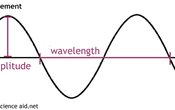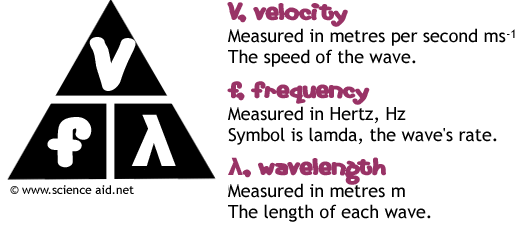Properties of Waves
Edited by Jamie (ScienceAid Editor), Taylor (ScienceAid Editor), Ali_ch0, SmartyPants and 3 others
About Waves
Above is a displacement/distance graph showing a wave. It is labeled with some key terms.
Parts of a Wave
- 1The amplitude is the height of the wave from 0 displacement (normal) to the peak at its highest point.AMPLITUDE.Advertisement
- 2The Wavelength is the distance from the start to the second point the wave passes 0. i.e. a complete wave.WAVELENGTH.
- 3On a displacement/time graph, the period would be equivalent to the time of the wavelength. The frequency is 1 / period and measured in Hz (1Hz = 1wave per second).PERIOD.
The Wave Equation
Have a look at the examples using this equation, below. A loudspeaker reproduces a note of frequency 320Hz. It travels through the air at the speed of 340ms-1.
A. What is the wavelength in air? l = v/f l = 340ms-1 / 320Hz l = 1.06m
B. The sound passes through water where its wavelength is 4.5m. Calculate the speed of sound in water V = fl V = 320Hz x 4.5m (frequency doesn't change) V = 1,440ms-1
Types of Waves
There are two basic types of wave. They are
- 1
- 2The oscillations/vibrations are along the line of travel. These are mechanical waves because it actually moves particles. E.g. sound waves.Longitudinal Wave.
Questions and Answers
For mechanical waves how are they created and how are they similar to electromagnetic waves?
I know that Mechanical waves require a medium and electromagnetic do not but I do not know if the parts of the two waves are the same for the both waves or if they are created differently. Do all waves require the same parts to form the waves like electromagnetic waves and are there different things we need to know about who similar or different they are from each other. I have tried: Search other websites and found only a few details and not enough information. I think it was caused by: I'm so lost I don't know. I know the mediums are required but I'm so confused on what they mean about that.
The difference between mechanical and electromagnetic waves is that the earlier needs a medium to penetrate through such as air, water, etc. whereas the later (electromagnetic wave) does not need a medium to penetrate through and can penetrate in the vacuum. A typical example of an electromagnetic wave is a light signal and an example of a mechanical wave can be the ripples formed on the surface of the water when a stone is thrown. Do you mean by parts as the amplitude, the wavelength, etc? There is no difference, as both types of waves will have amplitudes, crests, troughs wavelengths and others but not necessarily the same shape or magnitude.
What is the crest of a wave? Can you show a diagram?
I need to show a diagram and I have to show a side view and label the crest, trough, and amplitude.
Below is a diagram that shows the crest, the trough, and the amplitude:
When waves displace the material/medium/space they travel through, what happens to that displaced stuff?
I understand waves displace the material through which they travel, but what happens to that displaced stuff? Especially when the wave travels through space where there is no stuff... as I understand it. Does the displaced stuff have more energy in it after the wave goes through? I didn't see any discussion of the displacement that a wave causes and what happens during that displacement. Is this question addressed best by classical physics or does it entail some quantum discussion? I have tried: Just starting my investigation and I found your website. I think it was caused by: Not sure this question actually relates to what I am trying to find out.
ScienceAid QnA. This section is not written yet. Want to join in? Click EDIT to write this answer.
Referencing this Article
If you need to reference this article in your work, you can copy-paste the following depending on your required format:
APA (American Psychological Association)
Properties of Waves. (2017). In ScienceAid. Retrieved Apr 17, 2024, from https://scienceaid.net/physics/waves/properties.html
MLA (Modern Language Association) "Properties of Waves." ScienceAid, scienceaid.net/physics/waves/properties.html Accessed 17 Apr 2024.
Chicago / Turabian ScienceAid.net. "Properties of Waves." Accessed Apr 17, 2024. https://scienceaid.net/physics/waves/properties.html.
If you have problems with any of the steps in this article, please ask a question for more help, or post in the comments section below.
Comments
Article Info
Categories : Waves
Recent edits by: Sim, Sharingknowledge, SmartyPants












